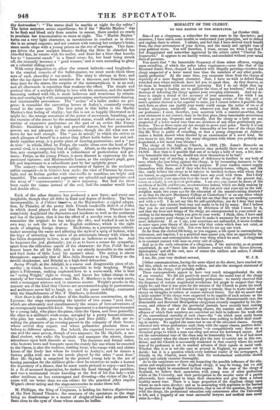THE THEATRES.
THE theatrical world is bursting into song: the scenic groves become vocal just as Nature's " bare ruiu'd choirs " are hushing; and stage sun- shine gladdens the long chilly evenings of autumn. The songsters of Drury Lane were audible on Saturday last; and those of the Princess's are tuning their throats against next Monday.
The Enchantress was the opera selected for the opening-night of Old Drury; Miss Romer essaying the part written for Madame ThWon. The grand novelty was the Parisian ballet called The Marble Maiden; a mag- nificent spectacle in three long acts, founded on the story of Pygmalion. The treatment that this classic legend has received at the hands of the French ballet-master is of a very extraordinary kind. The statue that is the object of its sculptor's passion is a Hebe with an hour-glass torso and pink extremities, wearing muslin petticoats and a wreath of artificial flowers on natural hair,—in short, a goddess every way qualified for a place among Madame Tussaud's wax-work worthies. The Genius of the Antique, we suppose, to punish the sculptor's had taste in making such a figure and his infatuation in idolizing the dressed doll, endows the painted image with life during the day; and the statue, after enjoying a day-rule of dancing and flirtation, is at night imprisoned in marble and condemned to do penance on its pedestal. The ministers of this vengeance are two awful antique statues--classic in style, and of colossal proportions, though only canvass in substance—who look down with stern contempt upon the pigmy plaster figures that surround them: and, as antiques cannot condescend to move or speak, their pedestals become oracular, and utter in illuminated characters these dark sentences—" The statue shall be animated during the day for thy destruction": " The statue shall be marble at night for thy safety." The latter sentence seems superfluous; for if the " Marble Maiden " was to be flesh and blood only from sunrise to sunset, there needed no oracle to proclaim her transmutation to stone at night. The " Marble Maiden " turns out a very light character, as meretricious in conduct as in dress: she is an arrant coquette, and not content with turning her sculptor's brain, must needs elope with a young prince on the eve of marriage. This faux- pas drives the poor sculptor frantic: finding the Hebe he chiselled has chiselled him, he retorts with his mallet, and deals her a blow that knocks her to " immortal smash " in a literal sense; for, her head being struck off, she instantly becomes a " good woman," and is seen ascending to glory on a celestial sliding-scale. With every disposition to allow the utmost latitude—and longitude— to the comical conceits of the ballet-master, we must needs think three acts of such absurdity is too much. The story is obvious at first; and after the lay-figure has been mistaken for a danseuse, and Dumilatre has done duty for the statue, the surprise of the metamorphosis is at an end; and all afterwards is repetition that weakens the effect. The simple and poetical idea of a sculptor falling in love with his creation, and the marble becoming endued with life, is made ludicrous and wearisome by reitera- tion and overlaying it with unmeaning pantomime, uncharacteristic dancing, and interminable processions. The " action " of a ballet makes no pro- gress: it resembles the curvetting horses at Astley's, constantly coming round to the same spot. The best point in this ballet is the Marble Maiden's first feeling of vitality; but this is not so happily illustrated as it might be: the strange sensations of the power of movement, breathing, and the exercise of the senses by the animated statue, would afford scope for a variety of expressive pantomime on the part of an artiste like Fanny Elssler. Dumilatre is a light and graceful dancer, but her pantomimic powers are not adequate to the occasion; though she did what was set down for her well enough. The " pas de miroir," in which she strives to catch glimpses of herself in a mirror that Albert holds before her and sud- denly snatches away, is a pretty piece of dancing-pantomime; and a " pas de trois " in which, lifted by Petipa, she vaults clean over the head of her mortal rival, is a surprising feat of agility. Albert, as the modern Pygma- lion, acts energetically, but with a redundance of gesticulation and gri- mace: Petipa, as the young Prince, is more discreet in expressing his im- passioned raptures; and Mademoiselle Louise, as the sculptor's pupil, gave life and importance to a subordinate part by her sprightly grace.
The scenery—the incongruous assortment of figures in the sculptor's atelier excepted—is in Grieve's best style: the view of Florence by moon- light, and an Italian garden with vine-trellis in sunshine, are bright and beautiful. The costumes and pageantry are splendid and appropriate; and the array of " supernumeraries " is most imposing. But had the show been made the means instead of the end, half the number would have had double effect.



























 Previous page
Previous page